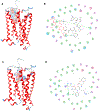Hemopressin as a breakthrough for the cannabinoid field
- PMID: 33212113
- PMCID: PMC8609950
- DOI: 10.1016/j.neuropharm.2020.108406
Hemopressin as a breakthrough for the cannabinoid field
Abstract
Hemopressin (PVNFKFLSH in rats, and PVNFKLLSH in humans and mice), a fragment derived from the α-chain of hemoglobin, was the first peptide described to have type 1 cannabinoid receptor activity. While hemopressin was shown to have inverse agonist/antagonistic activity, extended forms of hemopressin (i.e. RVD-hemopressin, also called pepcan-12) exhibit type 1 and type 2 cannabinoid receptor agonistic/allosteric activity, and recent studies suggest that they can activate intracellular mitochondrial cannabinoid receptors. Therefore, hemopressin and hemopressin-related peptides could have location-specific and biased pharmacological action, which would increase the possibilities for fine-tunning and broadening cannabinoid receptor signal transduction. Consistent with this, hemopressins were shown to play a role in a number of physiological processes including antinociceptive and anti-inflammatory activity, regulation of food intake, learning and memory. The shortest active hemopressin fragment, NFKF, delays the first seizure induced by pilocarpine, and prevents neurodegeneration in an experimental model of autoimmune encephalomyelitis. These functions of hemopressins could be due to engagement of both cannabinoid and non-cannabinoid receptor systems. Self-assembled nanofibrils of hemopressin have pH-sensitive switchable surface-active properties, and show potential as inflammation and cancer targeted drug-delivery systems. Upon disruption of the self-assembled hemopressin nanofibril emulsion, the intrinsic analgesic and anti-inflammatory properties of hemopressin could help bolster the therapeutic effect of anti-inflammatory or anti-cancer formulations. In this article, we briefly review the molecular and behavioral pharmacological properties of hemopressins, and summarize studies on the intricate and unique mode of generation and binding of these peptides to cannabinoid receptors. Thus, the review provides a window into the current status of hemopressins in expanding the repertoire of signaling and activity by the endocannabinoid system, in addition to their new potential for pharmaceutic formulations.
Keywords: Cannabinoid; Cannabinoid receptors; Endocannabinoid; Hemopressin.
Copyright © 2020 Elsevier Ltd. All rights reserved.
Figures




References
-
- Bénard G, Massa F, Puente N, Lourenço J, Bellocchio L, Soria-Gómez E, Matias I, Delamarre A, Metna-Laurent M, Cannich A, Hebert-Chatelain E, Mulle C, Ortega-Gutiérrez S, Martín-Fontecha M, Klugmann M, Guggenhuber S, Lutz B, Gertsch J, Chaouloff F, López-Rodríguez ML, Grandes P, Rossignol R, Marsicano G, 2012. Mitochondrial CB₁ receptors regulate neuronal energy metabolism. Nat. Neurosci 15, 558–564. - PubMed
Publication types
MeSH terms
Substances
Grants and funding
LinkOut - more resources
Full Text Sources
Other Literature Sources

